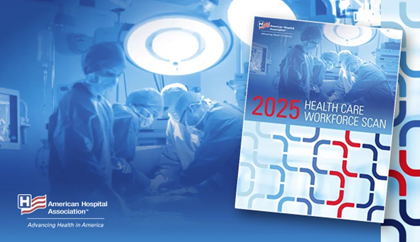
Achieving digital transformation has inherent challenges. Ideally, technology should streamline workflows and help organizations make better use of their data.
New solutions require corresponding workforce strategies, especially those related to training and support. This can be accomplished through:
- Refreshing teaching materials and approaches.
- Update workflows and clarify roles to ensure processes evolve based on end-user needs.
- Align ROI goals with the broader organizational strategy.
- Engage frontline managers and IT teams in their software purchases and deployments.
- Rigorously vet and test new technologies for patient safety and workflow compatibility, while focusing on improving user experience to avoid electronic health record (EHR) documentation burdens for clinical staff.
THE AHA 2025 Healthcare Workforce Analysis provides information on how to involve clinicians in your technology strategies.
The arguments in favor of continuing education
Today, leaders are focusing on continuing education that emphasizes not only the use, but also the value of new technologies.
For example, Texas Children’s Hospital in Houston used change management techniques during a major expansion and implementation of an EHR system. Leaders selected staff from across the organization to bridge the gap between the project team and their peers, helping to translate high-level project information into practical, day-to-day advice for their colleagues. They also met regularly to exchange ideas and report issues to the change management team.
Leaders also held dress rehearsals to prepare staff, setting up real-world simulations of the new EHR system. Staff practiced using the system and new processes before the actual launch. This helped employees understand what to expect and reduced anxiety. This also allowed the hospital to identify potential issues, such as incorrect user settings, before the system went live. This has led to smoother transitions and more positive attitudes during major organizational changes.
For example, hospital leaders compared two business units during the change process. Unit 1, which fully adopted change management practices, showed significantly better results than Unit 2, which did not. Unit 1 staff reported feeling more prepared, informed, and supported throughout the transition. This was reflected in higher participation rates at key activities such as dress rehearsals, where Unit 1 had more than double the staff commitment compared to Unit 2.
Before launching a virtual nursing program, which involved new technology for much of its staff, Inova Health System in Falls Church, Virginia, hosted a two-day innovation acceleration event focused on the efficiency and well-being of nurses. This involved the nursing team in developing program standards, which helped staff adopt changes to reduce documentation, support a new virtual nursing model, and increase the use of mobile applications for medication administration.
Kaiser Permanente found that addressing nurses’ perceptions of EHR use was as important as optimizing actual time spent on documentation. Its nurses felt overwhelmed using the EHR, even though data showed they spent less time there than average. Knowing that perceived workload affects stress levels and job satisfaction, leaders showed nurses personalized report cards highlighting EHR time in relation to patient workload. They communicated directly with busy clinicians, making connections and showing them data that proved the value of time spent documenting.
Anecdotal results have shown increased nurse satisfaction and better adaptation to new processes, particularly among new nurses. Leaders mentioned that empathy, support, and clear communication about the benefits of the new tools helped promote engagement.
3 things to think about
- How do you seek out and incorporate end-user feedback into your purchasing decisions?
- As roles change, how can you position technology as part of overall, continuous process improvement?
- How do you use IT professionals to bridge the gap between central hospital decisions and end users?
Download the AHA’s 2025 Healthcare Workforce Analysis to find out more.


